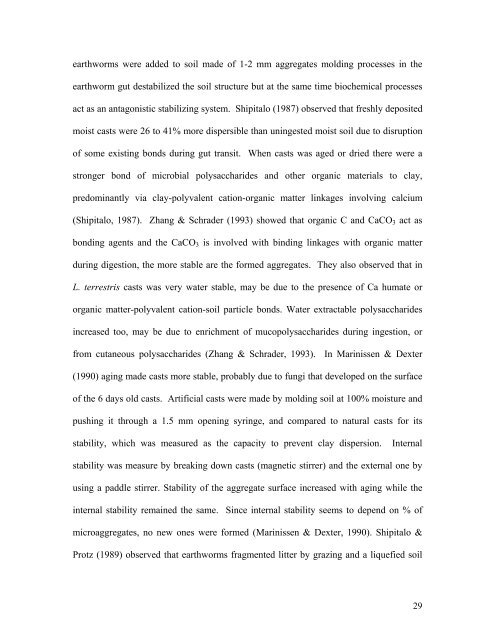Mekelle University The School of Graduate Studies Faculty of ...
Mekelle University The School of Graduate Studies Faculty of ...
Mekelle University The School of Graduate Studies Faculty of ...
- No tags were found...
Create successful ePaper yourself
Turn your PDF publications into a flip-book with our unique Google optimized e-Paper software.
earthworms were added to soil made <strong>of</strong> 1-2 mm aggregates molding processes in theearthworm gut destabilized the soil structure but at the same time biochemical processesact as an antagonistic stabilizing system. Shipitalo (1987) observed that freshly depositedmoist casts were 26 to 41% more dispersible than uningested moist soil due to disruption<strong>of</strong> some existing bonds during gut transit. When casts was aged or dried there were astronger bond <strong>of</strong> microbial polysaccharides and other organic materials to clay,predominantly via clay-polyvalent cation-organic matter linkages involving calcium(Shipitalo, 1987). Zhang & Schrader (1993) showed that organic C and CaCO 3 act asbonding agents and the CaCO 3 is involved with binding linkages with organic matterduring digestion, the more stable are the formed aggregates. <strong>The</strong>y also observed that inL. terrestris casts was very water stable, may be due to the presence <strong>of</strong> Ca humate ororganic matter-polyvalent cation-soil particle bonds. Water extractable polysaccharidesincreased too, may be due to enrichment <strong>of</strong> mucopolysaccharides during ingestion, orfrom cutaneous polysaccharides (Zhang & Schrader, 1993). In Marinissen & Dexter(1990) aging made casts more stable, probably due to fungi that developed on the surface<strong>of</strong> the 6 days old casts. Artificial casts were made by molding soil at 100% moisture andpushing it through a 1.5 mm opening syringe, and compared to natural casts for itsstability, which was measured as the capacity to prevent clay dispersion. Internalstability was measure by breaking down casts (magnetic stirrer) and the external one byusing a paddle stirrer. Stability <strong>of</strong> the aggregate surface increased with aging while theinternal stability remained the same. Since internal stability seems to depend on % <strong>of</strong>microaggregates, no new ones were formed (Marinissen & Dexter, 1990). Shipitalo &Protz (1989) observed that earthworms fragmented litter by grazing and a liquefied soil29
















